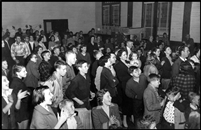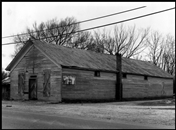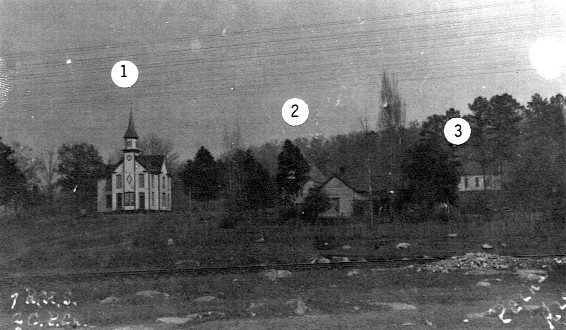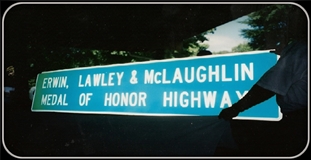









to be sure it is as accurate as possible. If you use this information please be courteous and give "credit where credit is due." Thank you. |

Photo Description: A lay of the land of Pelham before 1909. Building No. 1 is the Rutherford High School; Building No. 2 is the Cumberland Presbyterian Church; Building No. 3 is the Methodist Episcopal Church, South. Rutherford High School and the Cumberland Presbyterian Church was destroyed by a "cyclone" on April 12, 1909. Note the Methodist Episcopal Church is facing North, it was later "turned around" to face U.S. Highway 31. The house in the photograph, in front of and between Building No. 2 and Building No. 3, is the Turpin Family house. The original of this photograph, along with many other "old" original photographs of Pelham, are in a collection owned by Bobby Joe and Diane Seales.
|
Shelby County was created by an act of the Alabama
Territorial General Assembly on February 7, 1818, before Alabama became
statehood on December 14, 1819. Shelby County was named for Isaac Shelby,
Kentucky's soldier and first governor of Kentucky, who had been a Revolutionary
War hero and had refused election to a second term as governor in order to fight
the Indian Wars. "Shelby County Alabama is a county older than its state."
 Lee Street is congruent to what once was known as The Ashville-Montevallo Road, which served as their major stagecoach road of travel. For many years U.S. Highway 31, first a two-lane highway and much later a four-lane highway, was the only highway that would carry you through Pelham from the North and South directions. Today, there is also Interstate 65. The original old Shelby County courthouse records are currently maintained at the “Old 1854 Courthouse” located in Columbiana, Alabama, operated by the Shelby County Historical Society, Inc. The Shelby County Museum & Archives is housed in this 150+ year-old building that is on the State and National Register of Historic Places. The Shelby Guide, Columbiana, Tuesday, April 23, 1872, “Letter from Pelham … Mr. Editor: Permit us to say a word in behalf of our little village, situated in the Cahaba Valley, (on the play ground of my childhood) on the South and North Railroad, two and a half miles below the wonderfully growing town of Helena, and nineteen miles from the famous city of Birmingham, fourteen miles from the anticipated city of Calera, and in a community that will rank with any in the State in point of intelligence – every man for miles around takes the Guide. About two weeks ago eight or ten lots were purchased jointly by Col. J.F. B. Jackson, the energetic contractor of the South and North Alabama Railroad and Mr. A. Shaw, the popular and efficient Assistant Superintendent of the S. & N. road, Col. J.C. Robinson, of Selma, Ala., all of whom are men of capital and influence. We now have one store owned by J.C. Robinson, he keeps everything usually kept in a village store; one physician, Dr. W.B. Cross, whose past skill and social disposition rarely fails to disperse all gloom from the sick room; one boarding house, kept by our worthy friend Alex. Richards, who offers to the public as good fare and on as reasonable terms as can be had at any station on the road; one picture gallery, by C.C. O'Bar, who does first-rate work; one blacksmith shop and a rock quarry. Our depot building, which is in state of completion, is said to be the best on the road. The energetic citizens of the village and vicinity have just completed a large and commodious Academy, built on the latest and most improved style, and have an interesting school under the superintendence of Rev. C.L. Kirksey, nearly fifty pupils – one-fifth from various parts of the County and State; also one grist and flouring mill, owned by W.C. Denson, and one by Mr. Lee; one brickyard by Capt. Ransom who now has several thousand brick out under the frying influence of “Old Sol.” And just as certain as “Old Sol” continues to shine, if we can get “Honest John” to come up and take an owl's eye view of the place and blow us an honest blast on his sonorous horn, we will eclipse Birmingham and take Helena in out of the cold, and have the court-house back within one quarter of a mile of where it formerly stood. But before we close a word of caution to – “But since Sip is dead” nothing more should be said – peace to his memory and a long life to his “Friend.” Every yours honestly, Bilibus.” The “Alabama State Gazetteer and Business Directory” dated 1887-1888, describes Pelham as follows: “Shelby County; L&N Railroad; A village, 20 miles northwest of Columbiana, the county seat, and 78 miles north of Montgomery; Bank at Birmingham; Population 250; Express, Southern; Mail daily, Wm. Oates, postmaster.” Businesses listed were: “C.C. O'Barr, dentist and shoemaker; M.J. O'Barr, hotel; E.F. Benson, physician; W.C. Benson, grist mill and justice; A.W. Cost, constable; James Cost & Son, general store; W.P. Cost, blacksmith; W.S. Cross, general store; Fuller & Harris, lumber manufacturers; W.R.K. Johnson, physician; Rev. T.B. McCain [Methodist]; Mackey, Benson & Co., general store; S.R. Oates, general store; Rev. E.H. Taul [Baptist]; Rev. D.Y. Wyatt (Rev. David Young Wyatt, 1832-1897) [Presbyterian].” The Birmingham News, dated Sunday, April 8, 1923, "Superior Lime and Hydrate Company, recently organized, has broken ground at Pelham, less than 20 miles south of Birmingham, for kilns and other works for the manufacture of cooperage lime, hydrated lime and bulk lime and within two and half months 250 barrels daily production to be had, and by July 15 the full operations to be on, 500 barrels of lime daily to be the output. The company is headed by W.D. Lewis, who for years was connected with the Standard Portland Cement Company's plant at Leeds, and in 1918, when the Atlas Company took over the plant, he went with and is still interested in the Standard Fuel & Material Company, a successful local concern. H.G. Bridgewater, secretary and treasurer of the company, has been general manager of the Longview Lime Works for many years and is an expert lime manufacturer. There is an abundance of lime rock at Pelham, the works to be placed between the tracks of the Louisville & Nashville Railroad and the Atlanta, Birmingham & Atlanta Railroad, within two miles of a coal mine and a very short distance from a cooperage plant which is furnishing the lime works with barrells. The market for lime is very strong and promises to be more so as time passes. While most lime is used for building purposes, no little is being shipped from this state at present to paper mills, to steel plants and chemical works and later on will be used as a soil sweetening product. The new industry will give employment to a few men at the start and as the developments are pushed more men will be put to work." The Birmingham News, dated Saturday, August 15, 1925, "Development in the lime and limerock fields of Shelby county are being pushed and production being speeded up, according to announcements from that section, the lime and stone movements from that portion of the district showing healthy increases recently. The Superior Lime & Hydrate Company, of which H.G. Bridgwater is president, has plans completed for the addition of two modern kilns. Though but two years in operation this concern is shipping 500 barrels of lime daily, the product being used extensively in this state. The plant is operating day and night. It is located on the Louisville & Nashville and Atlanta, Birmingham & Atlanta lines." [Obituary Shelby County Reporter, dated Thursday, April 10, 1947] "Henry Goodlow Bridgewater (1883-1947), prominent citizen of the Pelham community, died Wednesday, April 2, at Daytona Beach, Florida, after a long illness. He was 63 years old. Funeral services were held Friday in Birmingham with burial in Elmwood cemetery. Mr. Bridgwater, a native of Kentucky, founded the Superior Lime and Hydrate Company at Pelham in 1923, which he operated until failing health forced his retirement from the business. He was a 32nd degree Mason, a member of the Shrine and Scottish Rite and a member of Temple Emanu-El. Surviving are his wife, Mrs. Rosa Loveman Bridgewater and three daughters, Misses Frances, Virginia and Katherine Bridgewater." This plant was later known as "Pelham Lime Company" and finally "Alabama Aggregate Company" featuring Agricultural Limestone, Road Stone, Concrete Aggregate and Railroad Ballast. On March 30, 1964 a public meeting was held in the Pelham School Building for discussing the incorporation of the Town of Pelham. Thirty-five people attended this meeting and Mr. Paul Yeager acted as the moderator. Pelham was officially incorporated as a Town on July 10, 1964, at which time they had a population within their boundaries of 654. A public election was held on September 1, 1964 and Paul Yeager was elected Mayor. The following received a majority vote in the race for Council: A.M. Hinds [Place No. 1], Allen Wilson [Place No. 2], J.T. Shelton [Place No. 3] and Joe Hodges [Place No. 5]. A runoff election for Place No. 4 was held between Burk Dunaway and Roy David Jowers. Burk Dunaway won. Pelham became the 11th incorporated municipality in the county. Mayor Yeager believed in the growth and progress of the Town and that the first major project of the Town would be to "put in a water system and have fire protection." Mayor Yeager called the first meeting of the Town Council on the 5th day of October 1964. Mrs. Willie Mae Lee Dennis (1922-2009) was elected Town Clerk. Mr. Allen Wilson was nominated as Mayor Pro Tempore. The Board of Education and the State of Alabama deeded the former Pelham Elementary School building and the property to the Town for a Town Hall. The Police Department was organized and a car purchased, fully equipped. Mr. L.A. Wilkerson was appointed to serve as the first policeman. Later Mr. James M. Coates served on a part-time basis. Founded in 1964 as a volunteer fire department, Roy David Jowers served as the first volunteer Fire Chief. For ten years Mr. O.C. Ray served as the second volunteer Fire Chief, until the fire department evolved into a full-time department with William A. “Bill” Bryars as the first full-time Fire Chief. On March 1, 1965 the water system was the item of discussion. On December 6, 1965 Mr. Roy Damron accepted the job as Chief of Police and also became the Superintendent of the Water Works Board. In October 1965 a well was drilled on Town property but was not satisfactory. A new well had to be drilled. Mayor Yeager worked untiringly to secure every possible means of getting the water system installed. Mr. Ralph Sorrell and Mr. Willie Coates gave the land for the construction of the 300,000 gallon steel reservoir to be erected by Chicago Bridge & Iron Company of Birmingham, Alabama. The Town of Pelham was awarded a United States Water Loan on September 30, 1966. A second well was drilled in 1966 on this "newly" acquired property; and this well met all requirements. On Thursday, February 9, 1967, the huge tank was full of water and the dedication of the Water Works System was held. Mr. Kenneth Byrd, Engineer, Kenneth Byrd Company, turned the switch "for the system to be officially turned on." "The gateway of opportunity" began to open in August
1966 when Moore-Handley, Inc. moved their facilities into the area. The Bank of
Pelham was organized and chartered in 1972 and it's building was located in the
"new" Pelham Plaza Shopping Center. Today, Pelham is one of the fastest-growing
cities of its size in Alabama. Located in the foothills of Oak Mountain, scenic
neighborhoods offer a retreat from the busy world. It's a wonderful place to
call home and a great place to visit. Businesses have discovered this ideal
location and understand why people love this community. With the Pelham Civic
Complex, world-class Pelham Racquet Club, Oak Mountain Amphitheater, Oak
Mountain State Park and Ballantrae Golf Course, Pelham definitely has a wide
variety of recreational opportunities for everyone to enjoy. As a leading
community in Shelby County, Pelham is the perfect place to be.
The first postmaster to serve the Pelham area was Mr.
William “Bill” Oates. His term ended in 1893 and Mrs. Cynthia Allen O'Barr began
her term. In 1915 she began operating the Post Office under the Civil Service
Act. Other early postmistresses were Mrs. Mary McGuire Walton, served from April
20, 1920 to April 30, 1954, and Mrs. Willie Brasher Yeager, served from May 1,
1954 until her retirement in January 1976. Other nearby post offices, now
located in the "present-day" city limits of Pelham, were: Highland Post Office,
established August 6, 1850, discontinued on July 25, 1866, re-established on
June 23, 1874 and discontinued on October 31, 1900. Richard S. Griffin served as
the first postmaster beginning August 6, 1850. Other postmasters were Squire H.
Burgess, Edward Bailey, Alvah Payne, William L. Cross, Matthew J.T. Harper,
Thomas B. Miller and James T. McGlown. Quito Post Office, established February
14, 1889 and discontinued on February 29, 1916. Susan V. Johnson was appointmed
the first postmistress on February 14, 1889. Other postmasters included Isaac
Johnson, William M. Allan, Walter E. Cross and William M. Allan. Also, at one
time the Keystone community had their own post office. Visit
History of Keystone and Its Lime Production ... one of the greatest of its kind in all the
Southern States.
"PELHAM - MORE HISTORY THAN YOU THINK!" Written by A.J. Wright YEAGER RITES ARE HELD, FORMER PELHAM MAYOR DIES Thursday, July 10, 1980, Shelby County News, "The city of Pelham was in mourning this week for the death of Paul Lloyd Yeager, the city's first mayor and the man who guided Shelby County's fastest growing municipality for 12 years. Yeager, age 66, died Thursday, July 3. Funeral services for the civic leader were held Saturday at Pelham United Methodist Church, with city, county, and other officials attending the services. An overflow crowd attended the services. burial followed in Pelham Cemetery with Valley Chapel directing. Yeager was first elected mayor of Pelham in 1964. He was re-elected to that post in 1968 and again in 1972. He helped guide Pelham during its early years and during the rapid growth years of the city in the late 1960's and 1970's... Survivors include his wife, Mrs. Willie Lavera Brasher Yeager; three sons, James Austin Yeager of Washington, D.C., David Winston Yeager of Virginia Beach, Va., and William Paul Yeager of Pelham; a daughter, Miss Patricia Anne Yeager of Pelham; a brother, Henry Yeager of Meridian, Miss.; and a sister, Mrs. Mableton Easterling." Thursday, February 16, 2011, Shelby County Reporter, "Alton Burk Dunaway, Jr., age 79, native and life-long resident of Shelby County, passed away Wednesday night, Feb. 9, 2011. He served on the original Pelham City Council for 12 years and was the city's second mayor for eight years. A U.S. Navy veteran, he was a member of Lakeview Pelham’s First United Methodist Church. Burk was preceded in death by his father and mother, Alton Burk Dunaway Sr. and Clara Ocie Braswell Dunaway. Survivors include Burk’s wife, Fay Dunaway; daughter, Kristie Thornton (Jason); son, Michael Dunaway (Shannon); grandchildren, Patrick Dunaway, Kenley Thornton and Zac Hinds; sister, Carrie Sue Hinds; and many cousins, aunts, uncles, nieces and nephews. The funeral service was at 2 p.m. on Saturday, Feb. 12, 2011, in the chapel of Ridout’s Southern Heritage Funeral Home, Pelham, with Rev. Stephen Strange officiating. Burial, Pelham City Cemetery." |